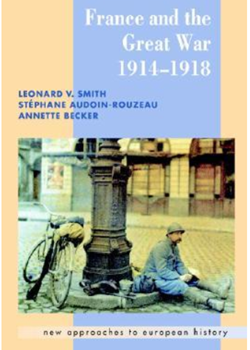France and the Great War, 1914-1918. Leonard V Smith, Stephane Audoin- Rouzeau and Annette Becker
- Home
- World War I Book Reviews
- France and the Great War, 1914-1918. Leonard V Smith, Stephane Audoin- Rouzeau and Annette Becker

Cambridge University Press, 2003, 218 pp, index, illustrations, maps, bibliography.
(New Approaches to European History). Cambridge: Cambridge University Press. ISBN 0 521 66631 7, £15.95 soft cover; ISBN 0 521 66176 5, £42.50 hardcover.
Kindle £25, Hardcover (New £111 - Used £66), Softcover (New £26 - Used £2) Prices as of 2022
Translations from the French are by Helen McPhail. Winner of the annual WFA-US Branch book award for 2003.
The Franco-American team collaborating on this history does not pretend to break new ground. Rather, the authors have created a work of synthesis. They return repeatedly to what they term 'war culture' to explain what made French society able to surmount its first great test of national unity of the 20th century. Five tightly but fluidly crafted chapters cover the road to war and the opening battles, mobilization, the front and the soldiers' war, the political and military crisis of 1917 and the ambiguous victory of 1918 and its aftermath. Much attention is paid to the place of the pre-war and wartime French army in society, the impact of war on civilians and veterans alike, and the political and economic mobilisation of the nation to meet the German invasion. In short, this is a sophisticated social history despite the fact that political, economic and military affairs are by no means ignored.
The impact of the Great War on the French nation is difficult to understate. German forces occupied and exploited fully French's most productive coal and steel works, as well as a large portion of its most productive farmland. Fifty percent of coal production, 64% of iron and 58% of steel production fell to the enemy in the first weeks of war. Unlike Germany and England, Successive governments successfully encouraged industrialists to organize themselves for war production, borrowed heavily overseas to obtain raw materials, and assured high profits to French investors. The war was financed largely by borrowing at home and overseas - over 43 billion francs on foreign markets by the end of 1918. Spectacular advances in worker productivity compensated for labour shortages; and, France became a leading world weapons producer and, briefly, 'the arsenal of democracy'.
In human terms, the war was devastating. Hardly a French family went untouched. And, its effects extend into the present day. The authors estimate that 39 million French men and women -- virtually the entire population —lost a friend or relative in the war. Of 8.4 million men mobilized from 1914 to 1918, over three million were killed, 300 thousand of them in the opening three months of war, the highest death rate (16.8%) among the Great Powers. Nearly 3.6 million men were wounded, many more than once. For hundreds of thousands of French caught behind enemy lines, the war was filled with economic and physical hardship, forced labour, deportations and daily humiliation at the hand of conquerors.
After reading this work, one wonders how the French nation survived the hecatomb and recovered, even considering the deleterious inheritance of the war in French civil society and the army of the 1930s. In all, this is a book replete with lessons worth absorbing as part of larger studies of the Great War and other twentieth century conflicts.
Review by Len Shurtleff
[This review first appeared in our journal Stand To! No.70 April 2004. Members receive Stand To! three times a year along with three copies of our in-house magazine Bulletin. The entire archive of Stand To! is available to members via their Member Login].





